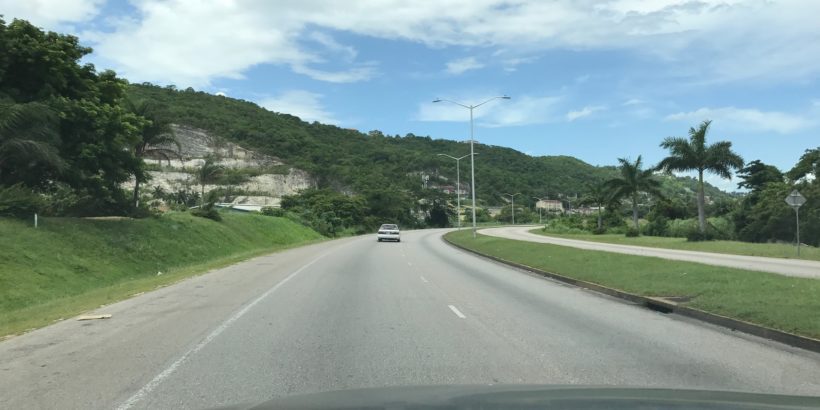Jamaica is a beautiful country with tons of great places to see and for that reason, it’s tempting to jump in a rental car and take off to explore the country. But there are a few things you should know about driving in Jamaica before you let loose.
Tip: Use WalletFlo for all your credit card needs. It’s free and will help you optimize your rewards and savings!
Rental cars
Renting a car from Montego Bay Airport is a pretty straight forward process. Montego Bay Airport offers some of the rental car brands you’ve probably used before like Avis and Budget but they also have Island and Sixt available, too. We went with Avis since we have status with them, but after scoring another older vehicle, I think we’re going to try to avoid them in the future.
You can get a compact car like a Yaris for $40 a day. A larger car like a Corolla would run you closer to $60 or $70 a day. And an SUV will be around $90 a day. Unlike many places outside the US, many of the vehicles have an automatic transmission, which is great for newbs like me who still can’t drive standard.
The rental car check-in desks are located inside the airport just before the exit and you’ll see signs pointing you to where you need to go — it’s not hard to find them at all. Once you’re checked in, you’re walked next door to a small parking lot surrounded by a chain-like fence where you’ll find your car.
After just a couple of turns and a round-a-bout, you’ll be out of the airport and onto the main road: A1.
They drive on the other side of the road
Jamaica didn’t obtain full independence from the UK until 1962, so when it comes to riding on the highways, the UK presence is still felt. This means that they drive on the opposite side of the road in Jamaica compared to the United States. If you’ve never driven on the other side of the road, this might not be the best place to learn, as I’ll explain in my next point.
People drive crazy
Jamaicans drive crazy — there’s no denying that.
They are bold. They are aggressive. And they do not care how close they come to your vehicle when the cut you off. It will only take you a few seconds on a main road or highway to see cars zipping in and out of lanes and passing cars, seemingly coming within milliseconds of a head-on crash. They also hit the gas hard, as if each stop light is the start of a new drag race and pink slips are on the line.
Of course, not everyone drives like that over there. But there’s enough people who drive like maniacs that it is a noticeable problem. If you’ve never driven on the “other”side of the road, I’d probably advise you to just get a taxi.
The good thing is that if you’re just wanting to drive from Montego Bay to places like Negril, you can pretty much stay on one road (the A1) the entire time. This simplifies the driving process a lot but still won’t remove the crazy drivers from the picture. On our 30 minute drive at night to explore the Luminous Lagoon (which I highly recommend), I had at least two “this is it… we’re gonna die” moments, and I consider myself a relatively worry-free traveler.
So the bottom line is if you’re worried about stressing out behind the wheel or ending up in an accident, just stick to taxis, shuttles, or tour busses. If you’ve got some experience with driving on the other side of the road and do okay when presented with obnoxious drivers, then you’ll probably be okay, so log as you’re prepared.
Crash statistics
Road traffic accidents have been viewed as a public health issue in Jamaica, they’ve been so bad. However, according to the World Health Organization, the road fatalities per 100,000 people per year, aren’t much worse than the US and the rates aren’t close to many of the African countries known for many fatal traffic accidents. So if you do choose to drive here, it’s not like you’ll be driving in the most dangerous place in the world.
Still, you need to be vigilant when driving in Jamaica if you’re not used to dealing with aggressive drivers.
Parking can also be an issue
If you’re trying to get to some of the beaches, you may find that parking is limited here and there are a lot of “reserved” slots. I’m not sure as to what level they enforce reserved parking but it made it problematic for us to find parking near a couple of beaches. Thus, I suggest heading out early in the morning to lock down a parking space and doing research beforehand to see what type of parking situation you can expect at your destination.
Final word
Overall, driving in Jamaica is not for everybody. If you’ve got no experience driving on the other side of the road and easily get stressed when behind the wheel, I don’t recommend driving. However, if you’ve been exposed to some pretty chaotic driving around the world or are an otherwise confident and skilled driver, I don’t think driving in Jamaica will be so bad for you.
Daniel Gillaspia is the Founder of UponArriving.com and the credit card app, WalletFlo. He is a former attorney turned travel expert covering destinations along with TSA, airline, and hotel policies. Since 2014, his content has been featured in publications such as National Geographic, Smithsonian Magazine, and CNBC. Read my bio.

